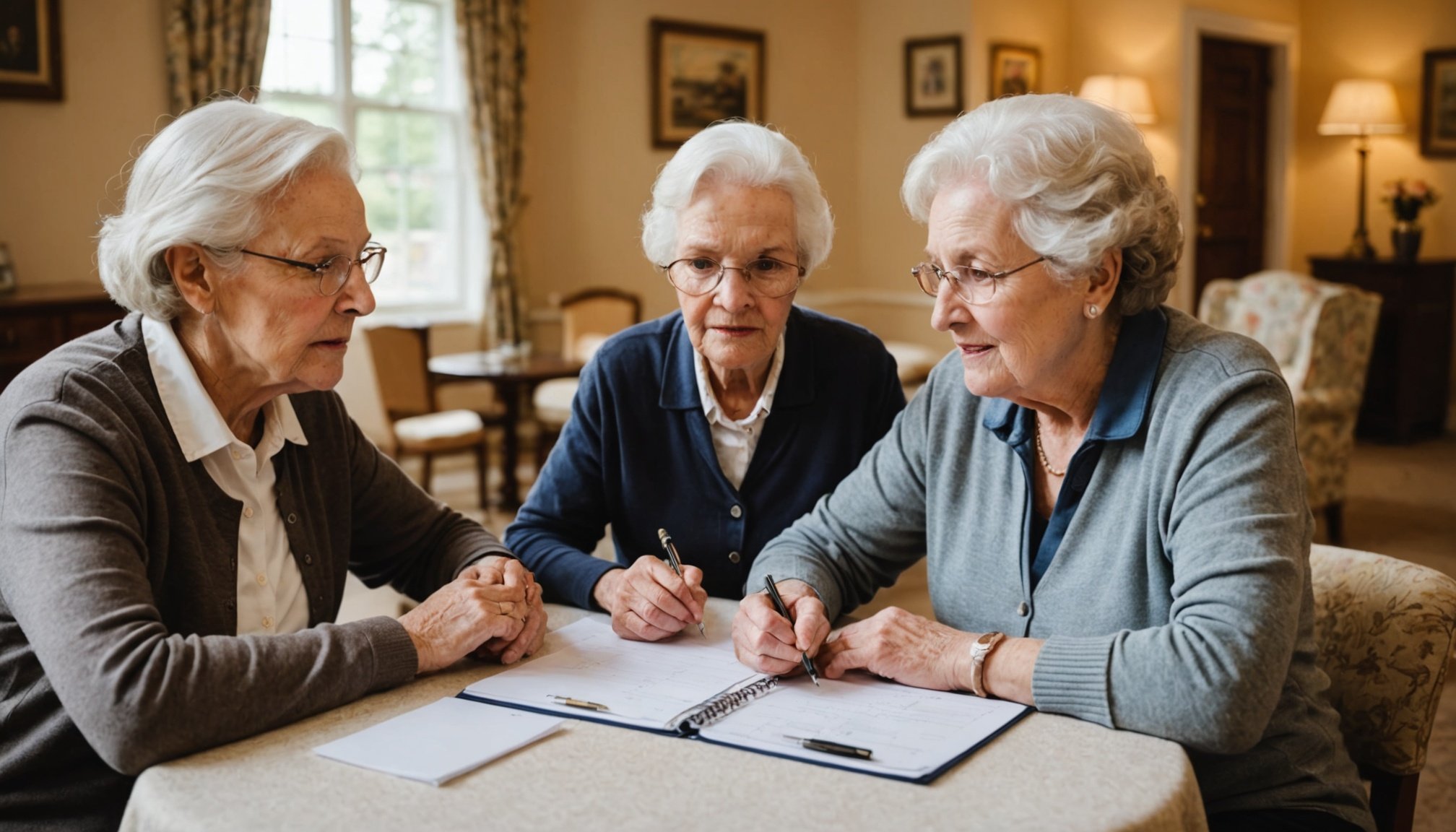Understanding Conflicts in Assisted Living Communities
Assisted living communities often face various conflict resolution challenges that stem from the unique setting and differing needs of residents. Common conflicts among seniors can include disagreements over shared spaces, noise levels, and even differing lifestyle choices. These disputes, although seemingly minor, can significantly impact the emotional well-being of residents.
Senior living challenges often arise from psychological factors, such as cognitive decline or past experiences that shape current behaviour. Emotional factors also play a critical role, as feelings of loneliness or anxiety can exacerbate tensions. Understanding these underlying causes is crucial for effective conflict resolution.
Also to discover : Optimal Breathing Strategies for Seniors Managing Asthma: Enhance Your Wellness
Addressing conflicts promptly is essential to maintain the residents’ emotional well-being. Ignoring disputes can lead to increased frustration, impacting daily life and overall happiness in the community. Solutions like mediation, open communication channels, and empathetic listening can aid in resolving issues swiftly.
Empathy and understanding from caregivers and family members are key in fostering a peaceful environment. By recognising the complex dynamics at play, conflicts can be managed more constructively, ensuring a harmonious living experience for all residents involved.
This might interest you : Maximizing Recovery: The Impact of At-Home Physical Therapy for Seniors Post-Surgery
Effective Communication Techniques
Effective communication skills are crucial for resolving disputes and maintaining harmonious relationships. One of the key strategies is active listening, which involves fully focusing, understanding, and responding to the speaker. This technique not only helps in accurately interpreting messages but also in mitigating misunderstandings, thereby facilitating clearer and more constructive dialogues.
In addition to active listening, verbal and non-verbal communication strategies are vital. Verbal strategies include clear articulation and open-ended questions, which encourage deeper discussion. Non-verbal cues, such as eye contact and appropriate facial expressions, reinforce these messages, adding an extra layer of comprehension to the interaction.
A significant aspect of effective communication is demonstrating empathy in conflict. Showing empathy involves understanding and acknowledging another person’s feelings and viewpoints, which plays a significant role in defusing tensions. Empathy, paired with validation of the speaker’s experiences, helps in building trust and openness, encouraging more honest and fruitful conversations.
By honing these communication skills, individuals can navigate conflicts with greater ease, fostering positive and productive relationships. Such skills are not only persuasive but also essential for maintaining interpersonal harmony and understanding.
Proactive Conflict Prevention Strategies
Creating a harmonious living environment requires a focus on conflict prevention through effective community engagement. Residents benefit immensely from a sense of belonging, which can be cultivated by fostering a vibrant community atmosphere. Open communication and shared experiences help reduce misunderstandings, which are often the root of conflicts.
Engaging residents in social activities is a crucial step towards creating this harmonious environment. Such activities serve as a platform for interaction, allowing individuals to connect on a personal level. This not only diminishes feelings of isolation but also strengthens community bonds. Regular events, like communal dinners or workshops, encourage residents to step out of their comfort zones and build relationships.
Furthermore, establishing peer support networks can be vital in addressing issues before they escalate. These networks provide residents with a sense of empowerment, knowing they have a support system to rely on. When grievances arise, having a peer network can facilitate discussion and resolution, mitigating potential conflicts. By encouraging community members to actively engage and support one another, the collective strength of the community is bolstered, leading to a more cohesive and peaceful environment.
Mediation Roles for Staff and Family
In assisted living environments, the role of caregivers often includes facilitating mediation between residents and their families. The staff utilise effective mediation techniques to ensure open communication and resolve conflicts. A primary role is to act as neutral facilitators, ensuring that all parties feel heard and respected. This mediation role is crucial in maintaining a harmonious living environment.
For family involvement, understanding and employing conflict resolution techniques can significantly enhance interactions. Families are encouraged to engage in active listening and empathetic understanding, promoting transparency. This collaborative effort helps build trust and fosters positive relationships. By being actively involved, families can better understand the needs and preferences of their loved ones, supporting more informed decision-making.
A collaborative approach benefits all parties involved. When caregivers and families work together, they create a cohesive support system that enhances the quality of life for residents. Benefits include improved relationships, reduced stress, and enhanced wellbeing for the elderly. Family involvement in mediation not only supports their loved ones but also allows for shared responsibilities, ensuring that care approaches are well-rounded and considerate of individual needs.
Case Studies of Successful Conflict Resolution
Conflict resolution can be tricky, but with the right strategies, it’s achievable. Here, we explore real-life conflict resolution examples to understand effective practices and outcomes.
One successful intervention involved a workplace dispute where two departments were in constant disagreement. The best practices used included open communication, mediation sessions, and collaborative problem-solving, ultimately fostering a harmonious work environment. This ensured both parties felt heard, leading to an amicable resolution.
In another case study from a community setting, conflict arose over resource allocation. Stakeholders used neutral facilitators to navigate discussions. By focusing on interests rather than positions, the parties achieved mutually beneficial solutions. Here, key practices included understanding diverse perspectives and maintaining transparency throughout negotiations.
Successful outcomes from these examples highlight the importance of active listening, compromise, and patience. Critical lessons illustrate that conflicts, though challenging, can be resolved constructively when one prioritizes empathy and genuine engagement. Adaptation of these insights to different contexts contributes to lasting peace and collaboration.
In summary, learning from these best practice models equips individuals and organizations with tools to effectively manage and resolve their own conflicts.
The Impact of Training and Education
Investing in staff training and ongoing education is pivotal in enhancing conflict management skills within any organisation. Effective training empowers employees to address and resolve disputes harmoniously, fostering a more productive and peaceful work environment.
Many organisations offer diverse training programs and resources to refine these crucial skills. These programs range from in-house workshops led by experienced facilitators to online courses focusing on advanced conflict resolution techniques. The choice of resources often depends on the organisation’s size, culture, and specific needs, allowing for customised learning experiences that best suit their workforce.
Ongoing education plays a vital role in adapting to ever-evolving workplace dynamics, ensuring that employees’ conflict resolution skills remain sharp and effective. Continuous learning fosters a culture of adaptability and empathy, encouraging staff to approach conflicts as opportunities for growth rather than obstacles.
An investment in continuous professional development not only equips employees with the necessary skills but also solidifies trust within teams. It assures staff that their leaders value harmonious interactions and are committed to maintaining a positive, collaborative atmosphere. These educational efforts result in a resilient workforce adept at navigating any challenges that may arise.
Understanding Conflicts in Assisted Living Communities
Conflicts in assisted living environments are not uncommon, as the very nature of senior disputes often arises from communal settings. These conflicts can range from disagreements over shared spaces to misunderstandings about personal preferences. Identifying the root causes of these disputes is crucial for maintaining a harmonious environment.
Several factors contribute to these disagreements, including differing lifestyles and personal habits. Seniors coming from varied backgrounds may have diverse expectations regarding noise levels, cleanliness, and shared responsibilities. Additionally, cognitive decline or health-related stresses can sometimes exacerbate misunderstandings, leading to heightened tensions.
Caregiver insights play a pivotal role in managing and mitigating these disputes. By observing the dynamics between residents, caregivers can identify potential sources of conflict early on. Addressing issues promptly can prevent escalation and promote a supportive atmosphere. Encouraging open communication and establishing clear community guidelines also assist in resolving misunderstandings before they develop into more significant issues.
Ultimately, addressing conflicts early ensures better outcomes for all involved, fostering an environment where seniors can enjoy a peaceful and cooperative communal living experience.
Communication Techniques for Conflict Resolution
Navigating a conflict can be challenging, but with effective communication, it’s possible to reach mutual understanding. The cornerstone of this process is open dialogue. By ensuring both parties can express their thoughts without interruption, misunderstandings are addressed head-on.
Active listening plays a crucial role in promoting empathy. This technique involves paying full attention to the speaker, acknowledging their message, and responding thoughtfully. For example, nodding and summarising what you’ve heard are powerful tools in confirming understanding.
In addition to verbal communication, non-verbal cues significantly enhance interactions. These include maintaining eye contact, using appropriate body language, and mirroring gestures to demonstrate attentiveness. Such cues can complement words, making the exchange more authentic and reassuring.
Another essential aspect is delivering and receiving feedback. Constructive feedback methods focus on positive reinforcement while gently addressing areas of improvement. Framing feedback in a constructive manner, using “I feel” statements instead of blaming, encourages a resolution-focused dialogue.
By mastering these techniques, individuals can transform conflicts into opportunities for growth and improved relationships. Empathetic and solution-oriented communication remains key in resolving disputes amicably.
Mediation Strategies by Care Staff
Effective mediation in care settings requires a strategic approach to conflict resolution, essential for promoting harmony and improving care environments. Care staff play a pivotal role in this process by employing advanced mediation tactics.
Training and Skills for Staff
Comprehensive training is crucial for care staff to acquire the essential skills for professional conflict resolution. Training programs should focus on improving staff’s communication abilities, empathy, and understanding of different perspectives within care settings. Equipping care staff with these skills ensures they can handle conflicts confidently and effectively.
Role-Playing Scenarios for Staff
Engaging in role-playing scenarios provides care staff with practical experience in mediating conflicts. These exercises simulate real-life situations, helping staff develop and refine their conflict resolution techniques. By practicing in a safe environment, staff can build confidence in their ability to resolve disputes amicably.
Implementing Neutral Mediation Approaches
Neutral mediation is vital for maintaining fairness in conflict resolution. Staff can implement neutral mediation by facilitating discussions objectively and impartially. To do this, they should gather all parties involved, focus on facts, encourage open communication, and guide participants towards mutually beneficial solutions. This approach helps foster a cooperative atmosphere, ultimately enhancing care quality.
Engaging Family Members in Conflict Resolution
Family involvement plays a crucial role in resolving conflicts effectively. When family members come together for discussions, they contribute diverse perspectives and experiences. This caregiver collaboration can lead to more comprehensive solutions, fostering a sense of unity and shared responsibility. Encouraging family participation begins with ensuring that everyone has a voice and feels heard, which can significantly ease tensions.
To communicate effectively with family members, it is vital to use active listening skills. This means paying attention, asking clarifying questions, and avoiding judgmental responses. Effective communication can transform discussions from arguments into problem-solving sessions, leading to constructive outcomes.
Additionally, creating a support system is essential for proper conflict management. Families can establish regular meetings or designated spaces to discuss issues openly. This not only aids in resolving existing conflicts but also strengthens bonds, promoting a healthier dynamic among family members.
Involving the entire family in these processes can make conflict resolution a more collaborative and supportive experience. Through such engagements, families can build a resilient foundation to navigate future challenges together.
Building a Positive Community Atmosphere
Creating a positive environment isn’t simply about maintaining aesthetics or amenities; it’s about nurturing a sense of belonging. Thriving community harmony begins with well-thought-out initiatives aimed at fostering deep connections among residents. Neighbourhood events and workshops can serve as platforms for resident engagement, encouraging interaction and teamwork.
Initiatives for Community Harmony
Initiatives such as community gardens or book clubs offer opportunities for collaboration while appealing to diverse interests. These projects allow residents to actively contribute, share skills, and grow friendships. It’s crucial to implement activities that cater to varied demographics to ensure inclusivity.
Activities and Programs for Inclusivity
Organizing events like cultural celebrations and skill-sharing workshops can promote involvement across different backgrounds. Initiatives like monthly meet-ups or family fun days can bring people together in informal settings, breaking down barriers and nurturing lasting bonds.
Celebrating Achievements
Equally important is recognizing individual efforts and accomplishments. Celebrating personal milestones or community contributions fosters a sense of pride and ownership. Acknowledging these achievements can lead to increased participation and a stronger commitment to maintaining the community’s well-being.
By understanding and leveraging these elements, communities can thrive, promoting unity, engagement, and overall satisfaction.
Resources for Further Support
To effectively navigate complex disputes, accessing the right Conflict Resolution Resources can be crucial. Whether you’re looking to handle family disagreements or workplace issues, several resources provide valuable guidance.
Books and Online Guides
Books and online guides are excellent starting points for understanding conflict dynamics. Delving into literature that focuses on identifying and addressing the root causes of conflicts can significantly enhance your resolution skills. Notable authors provide insights and frameworks that are widely recognised in the field. Moreover, interactive online guides often include scenarios that help you apply what you’ve learned in real-life settings.
Workshops and Training Sessions
Participating in workshops can be an enriching experience, as they offer hands-on practice. These sessions are designed to strengthen your ability in navigating disputes by offering Senior Support Services. Engaging in role-play and other interactive exercises can enhance empathy and communication skills, tailored to varying levels of conflict intensity.
Professional Mediators and Counselors
When issues escalate beyond personal capability, seeking Professional Assistance is advisable. Professional mediators and counselors bring expert perspectives and neutrality to conflict situations. They offer a safe environment to explore grievances while guiding all parties towards a mutual agreement. Their expertise is invaluable in situations that demand structured solutions.










